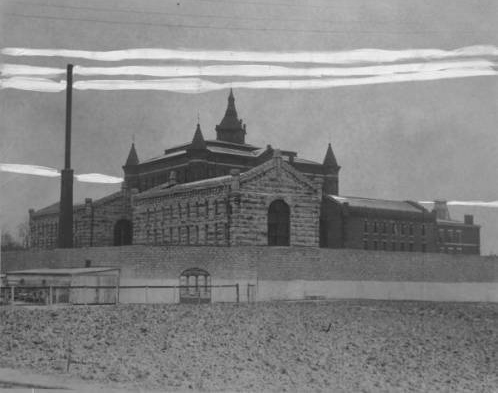
History
In early 1835 the city of Louisville purchased Joseph Chamberlin’s 100-acre Cave Hill farm in anticipation for the planned establishment of a cemetery, a poor house, and a workhouse.. Much of the land was later turned over towards the establishment of Cave Hill Cemetery in 1848. However a smaller patch at the corner of Payne St. and Lexington Rd. was reserved for the planned workhouse, as it contained a rock quarry used as a place to work city prisoners. Around 1851 construction was authorized on a cell block in close proximity to the quarry to house prisoners. By 1866, the inmate population had grown to 1,326. Louisville Mayor Philip Tomppert, in his 1867 annual address to the city council, proposed the construction of a new city workhouse as he believed the existing one was insufficient and in dire need of replacement. The next year, the practice of woman working in the quarry was discontinued.

It wouldn’t be until 1878, when then mayor Charles D. Jacob diverted $100,000 in funds from the city budget that construction finally began on updating the workhouse. With three new wings, a superintendents house, and overhauled main cell block completed, the refurbished workhouse officially opened on April 8, 1879 at a final cost of $105,000 and a capacity of 200 prisoners. For many years mining the quarry was the main source of work for many prisoners until it was nearly depleted in the late 1870’s. The brickyard was perminantly closed due to pressure from private brick companies. Afterwards prisoners would spend their days performing such duties as furniture building, farm work, and laundry. During the 1940’s workers began to make children toys for the citys less fortune at Christmas time.
Due to the decline in the prisoner population and building of newer city jails the idea of a ” city workhouse” was quickly becoming obsolete. On July 31, 1954, the last 15 prisoners were transferred to the Louisville city jail. The workhouse closed its doors for good the following day. After sitting vacant for many years, in September of 1957 the old workhouse became home to the testing center for automobile license, and the Louisville dog pound was established the following year. The dog pound moved to a new home in 1966 and shortly there after, the city announced plans to raze the buildings. After an extensive fire broke out in the vacant buildings on April 29, 1968, the remaining structures were quickly demolished. The land then sat vacant for a number of years until the city refurbished the land and established a street maintenance garage and Breslin community park and pool in 1974.
Louisville City Workhouse Image Gallery

















⁘ Works Cited ⁘
- Commonwealth of Kentucky (Frankfort, Kentucky). Report of the State Board of Control for Charitable and Penal Institutions to the Governor of the Commonwealth of Kentucky. OCLC 22134071. Special Collections, Kentucky Department for Libraries and Archives, Frankfort, KY.
Important note:
If you would like to use any information on this website (including text, bios, photos and any other information) we encourage you to contact us. We do not own all of the materials on this website/blog. Many of these materials are courtesy of other sources and the original copyright holders retain all applicable rights under the law. Please remember that information contained on this site, authored/owned by KHI, is provided under a Creative Commons Attribution-NonCommercial-NoDerivatives 4.0 International License.
Photographs, text, illustrations and all other media not authored by KHI belong to their respective authors/owners/copyright holders and are used here for educational purposes only under Title 17 U.S. Code § 107.

